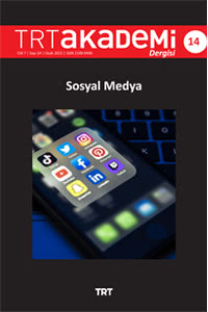GÖSTERİDEN YENİDEN ÜRETİME TELEVİZYONDA YAYINLANAN ŞAKA PROGRAMLARI
Kitle iletişim araçlarıyla üretilen söylemler, toplumsal ilişkilere dayalı somut yaşam deneyimlerinin yeniden üretilmesine dayanmakta ve izleyicinin yabancılaştığı birer gösteri nesnesi haline dönüşerek topluma sunulmaktadır. Medyatik söylemlerin toplumla olan bu yapay iletişimi, Guy Debord’un “gösteri toplumu” kavramına işaret etmektedir. Gösteri toplumunun bir üretim mecrası olan televizyonda toplumsal değerler, sıradanlaştırılarak insanların eğleneceği birer gösteri malzemesine dönüştürülmektedir. Bu kapsamda televizyonda yayınlanan “İlk Buluşma” adlı programda yer alan 84 şaka, içerik analizi ile incelenmiş, programda ön plana çıkarılan konulara göre 5 bölüm, eleştirel söylem analiziyle çözümlenmiştir. Çözümleme sonucunda kıskançlık, geleneksel aile ilişkileri, cinsiyetçilik ve suç gibi temalara dayanılarak içerik üretildiği, bu içerik üretim süreci sonunda ortaya çıkan ürünlerin Guy Debord’un gösteri toplumu teziyle benzerlik taşıdığı görülmektedir. Anahtar Kelimeler: Gösteri Toplumu, Guy Debord, Televizyon Programı, Toplumsal Değerler ABSTRACT Discourses, produces by mass media are based on the reproduce of the concrete experiences which based on social relations and they are presented to public, as an object of spactacle that alienate from the spectator.This artificial communication between the mediatic discourse and community refers to “The Society of the Spectacle” of Guy Debord. On Tv, which is a production area of the society of the spectacle, social values are been hackneyed and becomes the materials of the spectacle which humour the spectators. In this context, a Tv program, named “The First Date” has been studied and 84 prank in this program have been observed with content analysis, and 5 chapters that have been selected according to prominent themes, analyzed with discourses analysis. As a result, it has been emerged that contents in the program are produced based on themes like jealousy, traditional family relationships, sexism and blame. At the and of this process, it has also been emerged that, the produced contents correspond to Guy Debord’s “The Society of the Spectacle”. Keywords: The Society of the Spectacle, Guy Debord, TV Program, Social Values
Anahtar Kelimeler:
GÖSTERİ TOPLUMU, GUY DEBORD, TELEVİZYON PROGRAMI, TOPLUMSAL DEĞERLER
From Spectacle to Reproduction: Prank TV Shows
Discourses produced by mass media are grounded on the reproduction of the concrete human experiences which are based on social relations and they are presented to the public, transforming into an object of spactacle through which spectators are alienated. This artificial communication between the mediatic discourse and community refers to The Society of the Spectacle of Guy Debord. Social values are hackneyed and transformed into the materials of the spectacle which humour the spectators on television, which is a area of the production of the society of the spectacle. In this context, a TV program named The First Date has been studied and 35 chapters (84 pranks) in this program analyzed with content analysis. As a result, it has been emerged that produced contents of the program are based on themes such as jealousy, traditional family relationships, sexism and blame. At the and of this process, it has also been emerged that, the produced contents correspond to Guy Debord’s The Society of the Spectacle.
Keywords:
The Society of the Spectacle, Guy Debord, TV Program, Social Values,
___
- Adanır, O. (2012). Sinema Televizyon Kültür. İstanbul: Hayalperest Yayınları.
- Baudrillard, J. (2014). Simülakrlar ve Simülasyon.Ankara: Doğubatı Yayınları.
- Bourdieu, P. (1997). Televizyon Üzerine. (Çev: T. Ilgaz). İstanbul: Yapı Kredi Yayınları. Çelenk, S. (2005). Televizyon Temsil Kültür. İstanbul: Ütopya Yayınevi.
- Çelik,H. ve Ekşi,H.(2013).Söylem Analizi, htttp://dspace.marmara.edu.tr/bitstream/handle/11424/1193/1642-2956-1-SM.pdf?sequence=1(Erişim tarihi 11 Nisan 2018).
- Debord, G. (2017). Gösteri Toplumu. (Çev: Ayşen Ekmekçi-Okşan Taşkent)İstanbul: Ayrıntı Yayınları.
- Erdoğan, İ. ve Alemdar, K. (2002). Öteki Kuram, Ankara: Erk Yayınları.
- Ergül, H. (2000). Televizyonda Haberin Magazinleşmesi. İstanbul: Alfa Basım Yayım.
- Güllüoğlu, Ö. (2012). Bir Kitle İletişim Aracı Olarak Televizyonun Popüler Kültür Ürünlerini Benimsetme ve Yayma İşlevi Üzerine Bir Değerlendirme. Global Media Journal Turkish Edition, II (4), 64-86.
- Özgökbel Bilis, P. (2011). Çizgi Filmlerde Temsil Edilen ToplumsalDeğerler Sistemi. Yayınlanmamış Doktora Tezi. İzmir: Ege Üniversitesi Sosyal Bilimler Enstitüsü.
- Özkanal, B. (2011) Radyo ve Televizyonda Program Yapımı. Eskişehir: Anadolu Üniversitesi Yayınları.
- Robins, K., (2013). İmaj: Görmenin Kültür ve Politikası. İstanbul: Ayrıntı Yayınları.
- Sarmaşık, J. (1993). Radyo ve Televizyon Yayınlarının Denetim Yöntemleri. İstanbul : Marmara Üniversitesi Yayınları
- Türkoğlu, N. ve Toprak Alayoğlu, S. (2009). Medya ve Kültür. İstanbul: Urban Yayınları
- Uslu, Z.K. (2000). Televizyon ve Kadın. İstanbul: Alfa Yayınları
- Ünlüer, A.O. (2014). Farklı Kanallar Aynı Haberler. Ankara: Pelikan Yayıncılık
- Van Dijk, T. (2003). Critical DiscourseAnalysis. D.Schiffrin., D. Tannen, & E., H. Hamilton (Ed.), In The Handbook of Discourse Analysis. (352-372). Oxford: Blakwell Publishing.
- Yıldırım, A. ve Şimşek, H. (2006). Sosyal Bilimlerde Nitel Araştırma Yöntemleri. Ankara: Seçkin Yayıncılık.
- https://www.fox.com.tr/Ilk-Bulusma, İlk Buluşma Programı Web Sayfası, Erişim Tarihi: 26.01.2018.
- https://www.rtuk.gov.tr/yayinci-duzenlemeleri/3746/3908/yayincilik-etik-ilkeleri.html, Erişim Tarihi: 23.01.2018
- http://www.tdk.gov.tr/index.php?option=com_gts&arama=gts&guid=TDK.GTS.5a3d8b9cce4085.27176944, Erişim Tarihi: 20.01.2018.
- https://www.youtube.com/channel/UCI4k0KcOAqSwVOWEiNA2JRA/featured,
- İlk Buluşma Youtube Kanalı, Erişim Tarihi: 26.01.2018
- ISSN: 2149-9446
- Yayın Aralığı: Yılda 3 Sayı
- Başlangıç: 2016
- Yayıncı: TRT
Sayıdaki Diğer Makaleler
Gündelik “C Vitamininzi" aldınız mı? Peki ya, gündelik “ekranınızı?”
Gerçekliğin Paradoksal Yenilgisi: Televizyon Yarışmalarına Sosyopsikolojik Bir Bakış
Gazetecilik Filmlerinde Etik: State Of Play ve Nothing But The Truth Film Analizi
Yeni Medya Teknolojilerinin K-Kuşağının Ebeveynleri İle Olan İletişimine Etkisi
Mihrican TEPE, Aşina GÜLERARSLAN ÖZDENGÜL
Dijitalden Tatmak: Yemeğin “Yeni” Gastro Mekanlardaki Seyirlik Gösterisinin Kültürel Yansımaları
Ayşegül Elif ÇAYCI, Celalettin AKTAŞ
Post-Truth’un Gücü Adına: “Güç Bende Artık”
Yeni Medya Teknolojilerinin K-Kuşağının Ebeveynleriyle Olan İletişimine Etkisi
Ekran süresi’ kavramının artık modası geçmiş olduğu sonucuna varabiliriz.
